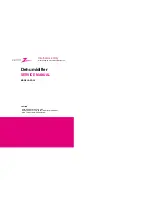
Installation
DRYPOINT® RS 15-550 HP50 NA
15
8.4
Connection to the compressed-air system
Danger!
Compressed air!
All works must only be carried out by qualified skilled personnel.
Never work on compressed-air systems which are under pressure.
The operator or the user must ensure that the dryer is never operated with a pressure exceeding the
maximum pressure value indicated on the name plate.
Exceeding the maximum operating pressure can be dangerous for the operator but also for the device.
The air temperature and the air flow at the inlet of the dryer must lie within the limit values indicated on the name plate.
The connecting lines must be free from dust, iron rust, shards and other contaminations and correspond to the flow rate
of the dryer. Should air with a very high temperature be treated, the installation of an aftercooler may be necessary. For
the implementation of maintenance works, the installation of a bypass system is recommended.
Note!
Pulsation and vibrations!
Pulsations and vibrations must be eliminated from the compressed air and IN/OUT piping to avoid possible
fatigue failure.
Do not use the dryer to treat air containing corrosive substances for copper and its alloys..
===== Ende der Stüc kli ste =====
Note!
Contaminated intake air!
In the event that the intake air is strongly contaminated (ISO 8573.1 class 3.-3) or poorer quality, we
recommend the additional installation of a prefilter (e.g. CLEARPOINT HP50S040), to avoid clogging of
the heat exchanger.
8.5
Connection to the cooling-water network
Danger!
Compressed air and unqualified personnel!
All works must only be carried out by qualified skilled personnel.
Never work on compressed-air systems which are under pressure.
The user must ensure that the dryer is never operated with a pressure exceeding the nominal values.
Possible overpressure can be dangerous for the operator but also for the device.
The temperature and the amount of cooling water need to correspond to the limit values indicated on the name plate.
The cross-section of the connecting lines, which should preferably be flexible, must be free from dust, iron rust, shards
and other contaminations. We recommend employing connecting lines (flexible hoses, vibration-inhibiting fittings etc.)
which protect the dryer against possible vibrations in the pipework.
Note!
Contaminated intake water!
In the event that the intake water is strongly contaminated we recommend the additional installation of a
prefilter (500 micron), to avoid clogging of the heat exchanger.
8.6
Minimum cooling water requirements:
Temperature
59…86°F (15…30°C) (1)
HCO
3
/ SO
4
>1.0 mg/l or ppm
Pressure
44...145 psig (3…10 barg) (2)
NH
3
<2 mg/l or ppm
Delivery pressure
> 44 psig (3 bar) (2) (3)
Cl
-
50 mg/l or ppm
Total hardness
6.0…15 dH°
Cl
2
0.5 mg/l or ppm
PH
7.5…9.0
H
2
S
<0.05 mg/l or ppm
Conductivity
10…500 μS/cm
CO
2
<5 mg/l or ppm
Residual solids
<30 mg/l or ppm
NO
3
<100 mg/l or ppm
Saturation mark SI
-0.2 < 0 < 0.2
Fe
<0.2 mg/l or ppm
HCO
3
7
0…300 mg/l or ppm
Al
<0.2 mg/l or ppm
SO
4
2-
<70 mg/l or ppm
Mn
<0.1 mg/l or ppm
Note:
(1)
– Other temperatures upon request – check the data on the name plate.
(2)
– Other pressures upon request – check the data on the name plate.
(3)
– Pressure difference at the water connection of the dryer at maximum water flow.
Other delivery pressures upon request.
CAUTION!
During the piping of the dryer, the inlet and outlet connections need to be supported as is shown in the
illustration.
Non-observance will cause damage.
Summary of Contents for DRYPOINT RS 100-E HP50 NA
Page 22: ...22 DRYPOINT RS 15 550 HP50 NA 10 4 Technical data DRYPOINT RS 180 550 3phase HP50 NA 3 380 60 ...
Page 40: ...Appendices 40 DRYPOINT RS 15 550 HP50 NA 13 1 2 Dryer dimensions DRYPOINT RS 50 80 HP50 NA ...
Page 41: ...Appendices DRYPOINT RS 15 550 HP50 NA 41 13 1 3 Dryer dimensions DRYPOINT RS 100 140 HP50 NA ...
Page 42: ...Appendices 42 DRYPOINT RS 15 550 HP50 NA 13 1 4 Dryer dimensions DRYPOINT RS 180 350 HP50 NA ...
Page 43: ...Appendices DRYPOINT RS 15 550 HP50 NA 43 13 1 5 Dryer dimensions DRYPOINT RS 450 550 HP50 NA ...
Page 47: ...Appendices DRYPOINT RS 15 550 HP50 NA 47 13 2 2 Exploded diagram DRYPOINT RS 15 40 HP50 NA ...
Page 48: ...Appendices 48 DRYPOINT RS 15 550 HP50 NA 13 2 3 Exploded diagram DRYPOINT RS 50 80 HP50 NA ...
Page 49: ...Appendices DRYPOINT RS 15 550 HP50 NA 49 13 2 4 Exploded diagram DRYPOINT RS 100 140 HP50 NA ...
Page 59: ...Appendices DRYPOINT RS 15 550 HP50 NA 59 13 3 2 Electric diagram DRYPOINT RS 15 40 HP50 NA ...
Page 60: ...Appendices 60 DRYPOINT RS 15 550 HP50 NA 13 3 3 Electric diagram DRYPOINT RS 50 80 HP50 NA ...
Page 61: ...Appendices DRYPOINT RS 15 550 HP50 NA 61 13 3 4 Electric diagram DRYPOINT RS 100 140 HP50 NA ...
Page 62: ...Appendices 62 DRYPOINT RS 15 550 HP50 NA 13 3 5 Electric diagram DRYPOINT RS 180 260 HP50 NA ...
Page 63: ...Appendices DRYPOINT RS 15 550 HP50 NA 63 13 3 6 Electric diagram DRYPOINT RS 350 HP50 NA ...
Page 64: ...Appendices 64 DRYPOINT RS 15 550 HP50 NA 13 3 7 Electric diagram DRYPOINT RS 450 550 HP50 NA ...
Page 71: ...DRYPOINT RS 15 550 HP50 NA 71 ...
















































